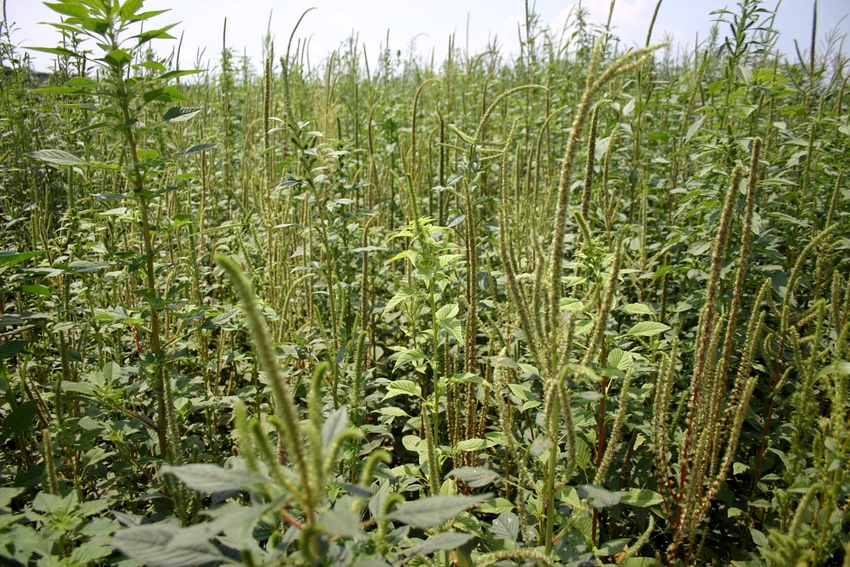
It hasn’t been easy, but east Arkansas’ Pace Hindsley has found success battling glyphosate-resistant pigweeds in his cotton fields. One of the featured farmers at the July 19 University of Arkansas Division of Agriculture-sponsored resistant pigweed field day in Marvell, Ark., Hindsley has adopted a “zero tolerance” approach to the pigweed problem.
Following the field day, Hindsley spoke with Delta Farm Press about his weed control program, his product choices, and how his 2011 cotton crop is faring. Among his comments:
On the field day…
“The field day was a success, it went very well. I think we got the word out that you can continue to grow Roundup Ready cotton in the Mid-South.
“You just have to have a plan and stick to it – follow that plan throughout. You can’t cut corners at this time due to the volume of (glyphosate-resistant) pigweeds. You’ve got to bring all your tools to the field in order to fight these weeds.
“Farmers should also know there are also company programs they can take advantage of. Monsanto and Syngenta are offering rebates when using some of the control products. We’d be using them anyway so you might as well get the rebates.
“Another thing worth pointing out: probably the best money I spent all year was investing in (Willmar) 915 hooded sprayers. That allows Gramoxone to be sprayed inside the hoods, plus residuals. Those turned out to be lifesavers for me this year.
“Actually, I wasn’t sure if we’d need the hooded sprayers because of all the other chemistries we were using throughout the field prior to lay-by. But it turned out I ended up having to use them. Thank goodness they were available and were able to clean the crops up very well and caught escapes.”
On the history of glyphosate-resistant pigweed in Hindsley’s fields…
“In 2008, we first began noticing isolated spots of pigweeds. Of course, at the time, we thought it was operator error, a sprayer wasn’t turned on or something messed up with the sprayer.
“However, in 2009, we noticed those spots of pigweed were growing larger. That’s when we ramped up efforts to fight them.
“In 2010, Ken Smith (University of Arkansas weed specialist) came here and we put together a program for a ‘zero tolerance’ field. He grid-sampled a particular field and counted pigweed seed in each sample. He implemented the control program and I followed it.
“At the first of this year, he returned and grid-sampled the same field within an inch. That showed the seed had been reduced by 90 percent in the soil.
“So, the zero tolerance control program I’m using doesn’t allow any pigweeds to go to seed in the field. That includes ditch banks, turn rows, etc.”
Success, product list
On the zero tolerance program’s success…
“Over a period of years, we could get up to 99 percent control.
“When I implemented the program there was still some hoe labor involved. In fact, this field had 110 hours of hoe labor.
“After using the zero tolerance program, hoe labor was under five hours total. That difference in chopping crews is significant.
“I’m very interested to see what the soil samples show in 2012.”
On future plans for his acreage…
“This year, I’ve got the program working across all 3,400 acres of cotton. You can really tell there’s a difference – night and day compared to (2010).
“Here’s what we’ve been using in the program. For burndown: 1.5 pints of Roundup and 1 pint of Gramoxone. We incorporate Treflan at 1.5 pints. One pint of Reflex goes on top of the beds. Behind the planter, we put out 1.5 pints of Cotoran broadcast. Over the top, we use 2.3 pints of Warrant and 1.5 pints of Roundup. We also use 2.5 pints of Sequence over the top.
“Under the new 915 hooded sprayers, we used 40 ounces of Gramoxone and a quart of Prefix. With the hoods, we can put out two applications. Under the cotton, we sprayed 1.5 pints of MSMA and 1 pint of Diuron.
“So, that’s a lot of different chemistries and mixtures. The key is to keep overlapping residuals. You can’t let one run out and expect to have very good control of the pigweeds.
“There is the possibility of escapes going from one year to the next. But by using this program, we’ve seen a 90 percent reduction in pigweed seed in the soil.
“The program cost me $78 per acre. With rebates, the price could drop down to the mid-$50s.”
On how Hindsley’s 2011 cotton crop has done…
“Luckily, our cotton ground is high and the floods didn’t affect us. The cotton was planted a couple of weeks later than usual but it got off to a good start.
“Right now, we’re in the middle of bloom. The crop looks really good and is canopied. We just need a timely rain. That would go a long way and save a lot of fuel for us since we’re steadily watering.
“Plant bug numbers have been up. We’ve sprayed quite a bit for those due to a lot of corn being grown in the area.
“Overall, though, the crop looks good and I’m very optimistic.”
About the Author(s)
You May Also Like




